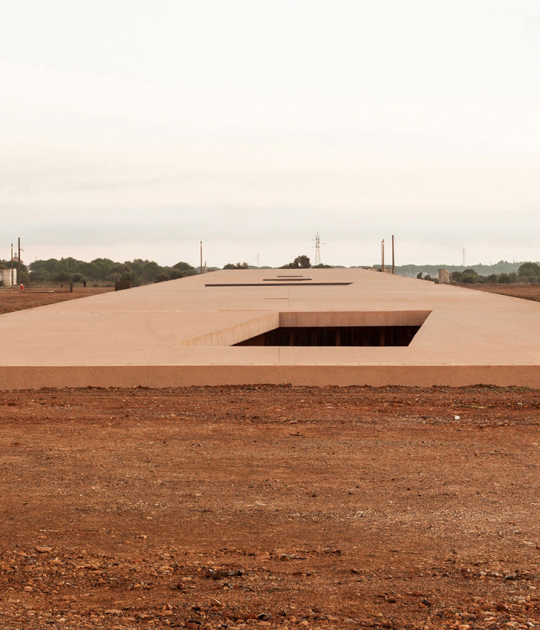Description of project by MSA/V+
This housing project fulfills the local authorities double ambition: to represent the urban revalidation scheme with a landmark at the entrance of the city and to provide exemplary apartments for large families. The building develops passive bright apartments and establishes a dialogue with the infrastructure and a the heritage neighbourhood.
Located at one of Brussels main entrances, the building is a social housing operation and a flagship project for the new identity of that neighbourhood. The building provides a solid and comfortable basis for families in need and stands with an open angle, welcoming commuters entering the capital. It advocates for a strong desire for architecture for all.
This one-piece construction closes a steep triangular block, and develops a smooth textured brick façade playing with the light of the ever-changing Belgium sky. This scripture echoes with the surrounding, full of details, art Deco perennial buildings and stands up to the impressive road and railway infrastructure.
As most projects in Brussels, the building had to face a fascinating but difficult context. To face the small, noisy and mainly northern orientated plot, the building uses key architectural features. It develops long folded apartments around a southern opened courtyard and a complex staircase that intertwines with individual stairs, allowing internal volumetric movements and kilometrical views to the surrounding landscape. The plans articulations, intricate as lace-work, and the progressive section, passing from split-level to inverted duplexes, provide all the apartments of this perennial construction with light from 4 orientations exposition, outdoor spaces, impressive views and numerous spatial experiences.
Being a visible part of a broader scheme, great expectations, local and regional, were put on the shoulders of this building. An exhaustive participative process was followed to establish a dialog with the inhabitants and the different competent administrations. It enabled to explain, develop and amend urban and architectural issues, diminishing recurring Brussels’ conflicts and allowing to exceed strict building regulations.
Because the building shelters people in need and because social housing shouldn’t be treated differently than more prestigious building, the project is developed in order to provide a solid basis to live in. The construction is comforting and perennial, you can sleep soundly, nails can be banged in the walls.
With super insulated envelope, soundproofing, triple glazing, balanced ventilation with heat recovery from exhaust air and solar panels for hot water production, the building is passive 15kwh/m² The inhabitants comfort and low consumption are ensured, while they’re still able to open all the windows.
The maintenance costs have been reduced to the maximum by avoiding air conditioning through calibrated exposure, by allowing natural light in nearly all the spaces and by the absence of an elevator, which the inhabitants didn’t notice, their ascension being eased by the spatiality and powerful views.
Special details, avoiding thermal bridges, and on site worker’s formations were developed to assemble the subtle white brickworks in order to obtain this strong texture to play with light and pay tribute to the heritage art-deco façades of the area.
The 2017 Emerging Architect Prize, Mies van der Rohe Prize, has been awarded to the Brussels studios MSA/V+ for the work NAVEZ - 5 social units at the northern entrance of Brussels, a housing project that fulfills the double ambition of the local authorities: to represent the urban revalidation scheme with a landmark at the entrance of the city and to provide exemplary apartments for large families. The client is the City of Schaerbeek.
The Mies van der Rohe Jury conveyed that housing is a vital topic throughout Europe and felt that MSA/V+ understood well and solved brilliantly the constructive and economic constraints of the programme and its site: 5 flats in a very small corner at the northern entrance of the city of Brussels. The Jury appreciated the high quality of the flats, which are unique and all provided with natural light from all orientations, outdoor spaces, impressive views and dynamic spatial experiences both in common and private spaces. They also recognised that the architects had carefully and meticulously worked with the integration of the building in the neighbourhood and the request to create a landmark.
More information
Published on:
May 12, 2017
Cite: "In NAVEZ as Northern entrance of Brussels, 5 social units by MSA/V+" METALOCUS.
Accessed
<http://www.metalocus.es/en/news/navez-northern-entrance-brussels-5-social-units-msav>
ISSN 1139-6415
Loading content ...
Loading content ...
Loading content ...
Loading content ...
Loading content ...
Loading content ...
Loading content ...
Loading content ...
Loading content ...
Loading content ...
Loading content ...
Loading content ...
Loading content ...
Loading content ...
Loading content ...
Loading content ...
Loading content ...
Loading content ...
Loading content ...
Loading content ...
Loading content ...
Loading content ...
Loading content ...
Loading content ...
Loading content ...
Loading content ...
Loading content ...
Loading content ...
Loading content ...
Loading content ...
Loading content ...
Loading content ...
Loading content ...
Loading content ...
Loading content ...
Loading content ...
Loading content ...
Loading content ...
Loading content ...
Loading content ...
Loading content ...
Loading content ...
Loading content ...
Loading content ...
Loading content ...
Loading content ...
Loading content ...
Loading content ...
Loading content ...
Loading content ...
Loading content ...
Loading content ...
Loading content ...
Loading content ...









































